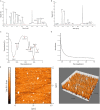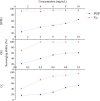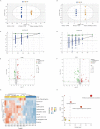Hepatoprotective effects of peach gum polysaccharides against alcoholic liver injury: moderation of oxidative stress and promotion of lipid metabolism
- PMID: 38283909
- PMCID: PMC10811791
- DOI: 10.3389/fnut.2023.1325450
Hepatoprotective effects of peach gum polysaccharides against alcoholic liver injury: moderation of oxidative stress and promotion of lipid metabolism
Abstract
Natural polysaccharides extracted from plants have received increasing attention due to their rich bioactivity. In our study, peach gum polysaccharides (PGPs) were extracted by water extraction-alcohol precipitation method. PGPs are typical pyranose polysaccharides with a mean molecular weight of 3.68 × 106 g/mol. The antioxidant activity and hepatoprotective capacity of PGPs were studied. In vitro, assays showed that PGPs scavenged DPPH, OH, and O2- in a dose-dependent manner. PGPs exhibited antioxidative properties against alcohol-induced HL7702 cells, as evidenced by the normalization of MDA, SOD, ROS, and GSH levels. To further elucidate the hepatoprotective mechanism of PGPs, we carried out in vivo experiments in male mice. PGPs exerted hepatoprotective effects in alcohol liver disease (ALD) mice by exerting antioxidant effects, decreasing the inflammatory response and modulating lipid metabolism. In addition, metabolomic analysis indicated that PGPs mainly regulate D-glutamine and D-glutamate metabolism, alanine, aspartate and glutamate metabolism, and arginine biosynthesis to promote hepatic metabolism and maintain body functions. Overall, this study revealed that the hepatoprotective mechanism of PGPs against ALD might be associated with the regulation of oxidative stress and lipid metabolism.
Keywords: alcoholic liver damage; antioxidant activity; metabolomic; peach gum polysaccharides; structural analysis.
Copyright © 2024 Zhou, Liu, Yao, Cao, Zhu, Wang, Liu, Fang, Wu and Gong.
Conflict of interest statement
The authors declare that the research was conducted in the absence of any commercial or financial relationships that could be construed as a potential conflict of interest.
Figures









Similar articles
-
The impact of ultrasonic-assisted extraction on the in vitro hypoglycemic activity of peach gum polysaccharide in relation to its conformational conversion.J Sci Food Agric. 2024 Aug 30;104(11):6947-6956. doi: 10.1002/jsfa.13527. Epub 2024 Apr 26. J Sci Food Agric. 2024. PMID: 38597282
-
Peach gum polysaccharides improve the spermatogenesis of KKAy mice with impaired reproduction system.Am J Reprod Immunol. 2017 Mar;77(3). doi: 10.1111/aji.12627. Epub 2017 Jan 5. Am J Reprod Immunol. 2017. PMID: 28054411
-
Hepatoprotective potential of Aloe vera polysaccharides against chronic alcohol-induced hepatotoxicity in mice.J Sci Food Agric. 2014 Jul;94(9):1764-71. doi: 10.1002/jsfa.6489. Epub 2014 Jan 2. J Sci Food Agric. 2014. PMID: 24272968
-
Antioxidant Activity and Protective Effects of Enzyme-Extracted Oudemansiella radiata Polysaccharides on Alcohol-Induced Liver Injury.Molecules. 2018 Feb 23;23(2):481. doi: 10.3390/molecules23020481. Molecules. 2018. PMID: 29473842 Free PMC article.
-
Recent advances in the role of polysaccharides in liver diseases: a review.Front Pharmacol. 2025 Mar 27;16:1535717. doi: 10.3389/fphar.2025.1535717. eCollection 2025. Front Pharmacol. 2025. PMID: 40213697 Free PMC article. Review.
Cited by
-
Capsaicin and Quercitrin Maintained Lipid Homeostasis of Hyperlipidemic Mice: Serum Metabolomics and Signaling Pathways.Foods. 2024 Nov 21;13(23):3727. doi: 10.3390/foods13233727. Foods. 2024. PMID: 39682799 Free PMC article.
-
Peach Gum Polysaccharide Prevents Chemotherapy-Induced Intestinal Injury and Degenerative Behavior.Integr Cancer Ther. 2025 Jan-Dec;24:15347354251368410. doi: 10.1177/15347354251368410. Epub 2025 Aug 23. Integr Cancer Ther. 2025. PMID: 40847988 Free PMC article.
-
Spectroscopic Relationship between XOD and TAOZHI Total Polyphenols Based on Chemometrics and Molecular Docking Techniques.Molecules. 2024 Sep 10;29(18):4288. doi: 10.3390/molecules29184288. Molecules. 2024. PMID: 39339283 Free PMC article.
-
Branched-chain amino acids: physico-chemical properties, industrial synthesis and role in signaling, metabolism and energy production.Amino Acids. 2024 Aug 28;56(1):51. doi: 10.1007/s00726-024-03417-2. Amino Acids. 2024. PMID: 39198298 Free PMC article. Review.
-
Volvariella volvacea Polypeptide Mitigates Alcohol-Induced Liver Injury: A Multi-Omics Study.Foods. 2025 Apr 29;14(9):1557. doi: 10.3390/foods14091557. Foods. 2025. PMID: 40361639 Free PMC article.
References
-
- Bian L, Chen H, Zhou X. Untargeted lipidomics analysis of Mori Fructus polysaccharide on acute alcoholic liver injury in mice using ultra performance liquid chromatography-quadrupole-orbitrap-high resolution mass spectrometry. Int Immunopharmacol. (2021) 97:107521. 10.1016/j.intimp.2021.107521 - DOI - PubMed
LinkOut - more resources
Full Text Sources

